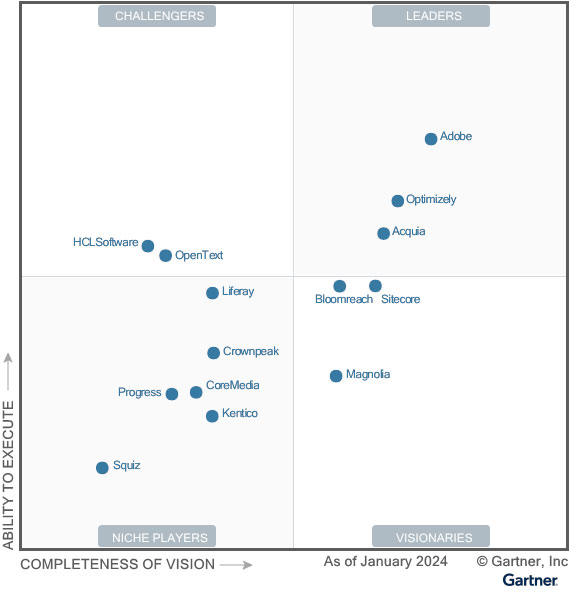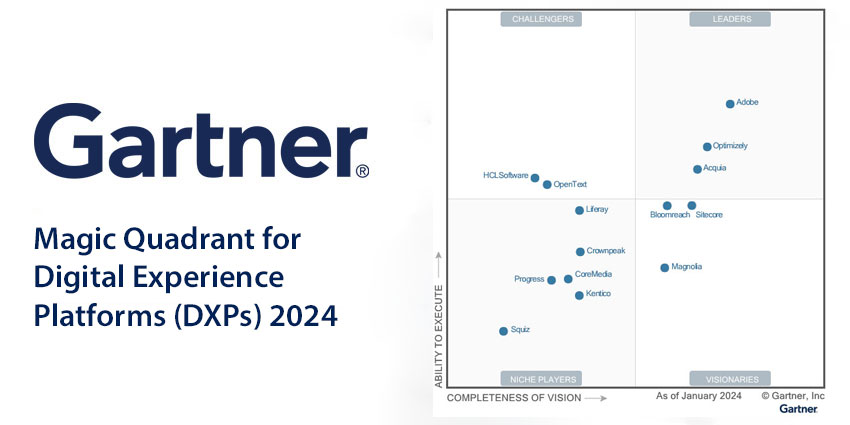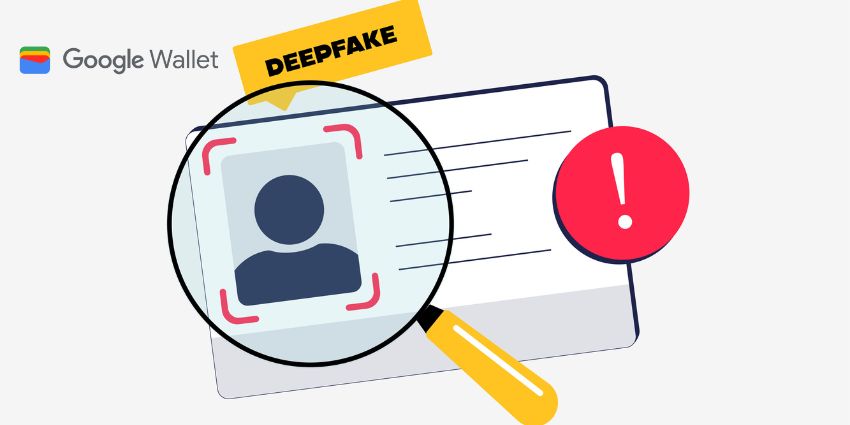As of 2023, 50 percent of organizations have received a mandate to acquire composable digital experience platform (DXP) technology, according to Gartner.
But, by 2026, the research firm estimates this will increase to 70 percent, so more brands can compose unique digital experiences for customers, employees, and partners.
That 20 percent hike could represent a significant growth opportunity for the many players in the DXP market.
Yet, it’s a broad market, as DXP suites unify many technologies, from content management and journey mapping solutions to analytics and reporting tools.
Thankfully, Gartner has evaluated the offerings of 14 prominent DXP providers, isolating three market leaders in the process.
The Definition of Customer Digital Experience Platforms
A digital experience platform combines solutions that help compose, test, optimize, implement, and manage digital customer journeys.
Core fixtures of the platform include content management, journey orchestration, and cloud-based solutions that fit within a composable architecture.
However, as DXPs gain traction, more features become standard. For example, these likely include account services for customer profile management, hyper-personalization functionality, and analytics for continuous optimization.
Customer journey mapping, customer data management, knowledge management, security, and applied AI are further examples of solutions buyers now expect from the platform.
Finally, it’s critical to note that DXPs also support business-to-employee (B2E) applications – alongside B2B and B2C use cases.
However, this is just a whistle-stop tour of the DXP market – as the sector is continually expanding, giving buyers lots to consider.
The Magic Quadrant strives to help, splitting 14 DXP vendors into four groups: Leaders, Challengers, Visionaries, and Niche Players – as shared below.

Gartner Magic Quadrant Leaders
Leaders in the Magic Quadrant support numerous DXP use cases, providing a track record for meeting customer requirements and expectations across each. In addition, they deliver cutting-edge product innovation that resonates with customers across various sectors. This year’s leaders are:
- Adobe
- Optimizely
- Acquia
Adobe
The Adobe Experience Cloud often appears on shortlists due to a widespread perception of the DXP being a “proven and mature” offering. Adobe backs this up with deep, innovative product features -especially for external-facing digital experiences – and its extended partner ecosystem. Those partnerships span creative, design, and advertising agencies alongside system integrators. As a result, Adobe’s customers have many partner options when implementing and leveraging its DXP.
Optimizely
Lots of large enterprises have implemented Optimizely One as their DXP of choice. Many may leverage a GraphQL API to unify data across the platform, bolstering its AI applications and organizational data strategies. Gartner highlights this API as a core strength, alongside the DXP’s “simple, scalable, [and] modular” pricing and packaging strategy. Finally, the analyst lauded how Optimizely has integrated its acquisitions, taking capabilities and spreading them across its platform.
Acquia
The Acquia Open DXP offers advanced, AI-driven journey mapping, personalization, and segmentation features, each embedded into an intuitive interface. That UI often appeals to less technical business users. Gartner isolates this as a plus point alongside the bustling open-source Drupal community and Aquia Exchange. The Exchange is its marketplace, which brims with connectors, modules, and pre-built integrations that extend across the vendor’s robust product portfolio.
Gartner Magic Quadrant Challengers
Challengers in the Magic Quadrant excel in their ability to execute with a portfolio that aligns well with many companies’ current demands. However, they lag leaders in their vision, as Gartner suggests they may “struggle” to satisfy the future demands many DXP customers. This year’s challengers are:
- HCLSoftware
- OpenText
HCLSoftware
The HCL Digital Experience (DX) platform is highly extensible, providing sector-specific use cases, integrations, and connectors for complex scenarios. Gartner recognizes this as a significant strength, in addition to its large global presence and user session licensing. The latter is a new platform feature that enables a more predictable and simplified consumption-based pricing structure. However, HCLSoftware’s DXP remains a “complicated proposition” for some customers – as per the analyst.
OpenText
Available on AWS, Azure, and Google, OpenText Experience Cloud offers robust security, governance, and account management credentials. As such, it can appeal to businesses in highly regulated sectors. Gartner pinpoints this as a plus for OpenText, along with its platform’s extensibility and broader information management capabilities. The latter include communications and content management tools. Nevertheless, OpenText struggles from perceptions of its tech as “legacy and outdated”.
Gartner Magic Quadrant Visionaries
Visionaries in the Magic Quadrant present a roadmap that demonstrates a deep understanding of emerging technologies and customer needs. Nevertheless, some aspects of their current execution – whether product-, ecosystem-, and/or service-related – trail leader’s. This year’s visionaries are:
- Sitecore
- Bloomreach
- Magnolia
Sitecore
Sitecore benefits from a humming application marketplace that offers 1,000+ third-party solution integrations, which brands can leverage via a visual, no-code integration tool. Meanwhile, its platform thrives from the addition of cloud-native solutions – such as Sitecore Discover and Personalize – alongside new capabilities like its decoupled experience studio and integrated form builder. Yet, well-publicized reports that Sitecore’s owner EQT is considering a sale may concern customers.
Bloomreach
The Bloomreach Commerce Experience Cloud comprises ten modules that customers can consume in parts. Gartner considers this compossibility – and how it extends to pricing – a core strength. It also commends Bloomreach for experiencing “strong” growth in a tough macro-environment and its approach to privacy and compliance. The latter also aids its success with commerce use cases. However, the analyst warns this commerce-centric approach may discourage other DXP buyers.
Magnolia
The Magnolia DX Core platform receives notably high satisfaction scores amongst verified customers, with many appreciating its commitment to support and building relationships. The platform also stands out for its compossibility and GenAI integration. These have blended impressively, demonstrating Magnolia’s agility when responding to technology shifts. Yet, Gartner warns of low brand awareness and a lack of native data management capabilities within the platform.
Gartner Magic Quadrant Niche Players
Niche Players in the Magic Quadrant have developed a healthy customer base and often deliver positive results in specific DXP deployment scenarios. Yet, their global footprint and cross-industry coverage are often blockers when competing with market leaders. This year’s niche players are:
- Liferay
- Crownpeak
- CoreMedia
- Kentico
- Progress
- Squiz
Liferay
The Liferay DXP lowers technical complexity for IT stakeholders. Yet, Liferay has also made strides in supporting non-technical users, making its solution much more accessible. Gartner applauds this, in addition to the vendor’s expertise in delivering differentiated portal experiences and its far-reaching, verticalized partner approach. This has powered its recent geographic growth. However, Liferay has slowly transitioned to a SaaS model, which lacks the compossibility of many competitive DXPs.
Crownpeak
The Crownpeak Digital Experience Platform shows flashes of unique innovation. For instance, it allows users to assess image generation and GenAI-driven texts with its digital quality assurance offering. That aids the rollout of auto-generated content. Gartner notes the innovation as a significant strength, alongside the vendor’s midsize enterprise focus and expanding product portfolio. Yet, that portfolio lacks depth in data management, journey mapping, and analytics.
CoreMedia
CoreMedia snapped up BySide and Smarkio in 2023. These acquisitions make CoreMedia the only vendor in this evaluation to blend digital service, sales, and marketing experiences with human interactions. This is a possible differentiator for brands invested in a total experience approach. CoreMedia has also done well to shift from a monolithic, single-vendor architecture to a more composable model with packaged integrations. However, verified customers report difficulties in setting up and using the CoreMedia Content Cloud platform.
Kentico
The Kentico Xperience 13 platform provides high ease of use thanks to its organic development and cohesive product strategy. That reflects in its clear-cut pricing model and go-to-market that targets midsize organizations. Gartner pinpoints these strengths and Kentico’s global partner program, which has an impressive, diverse membership, given the vendor’s size. Nevertheless, Gartner warns that the DXP lacks compossibility and notes how customers can confuse it with the Xperience by Kentico offering.
Progress
The Progress DX offering presents a native, conversational AI-assisted UI, which helps users leverage many of the features and pre-built integrations hidden within the platform. Verified customers also note that the UI is easy to use and intuitive for non-technical users, even when they perform tasks such as content targeting and form creation. Lastly, Gartner highlights the vendor’s progress in delivering “authenticated portal-like experiences”. Yet, the analyst labels its cloud strategy as “confusing”, and brand awareness as “low”.
Squiz
The Squiz DXP has enjoyed several “architectural advancements” over the past 12 months. Those advancements may have aided the user experience, with verified customers highlighting how the DXP is easy to deploy when correctly matched with their sector and use case. Gartner underlines this and notes the vendor’s employee experience features for collaboration and knowledge sharing as other core strengths. However, the analyst warns Squiz lags in its innovation – especially regarding AI, personalization, and customer journey management.
What Has Changed Since 2023?
The short answer: not a lot. For starters, there are no new vendors to appear within the quadrant, and none have dropped off. It’s the same set as last year.
Moreover, all but one has remained stuck to the same square as 12 months ago.
Indeed, Sitecore is the only vendor to have moved, with the vendor slipping from the leader to the visionary quadrant, as evident in the graphic below.

However, some have shifted slightly. For instance, Adobe has pulled closer to the top-right corner of the grid, opening up space between its closest rivals.
Meanwhile, Bloomreach has sneaked closer to the leader square, and Kentico has seemingly inched closer to the visionary quadrant.
Nevertheless, these are fractional changes, and – despite Gartner’s forecast of increasing investment into the space over the next two years – the vendor landscape seems settled.
Deep dive into more of our CX-related Magic Quadrant coverage by reading the following rundowns:







